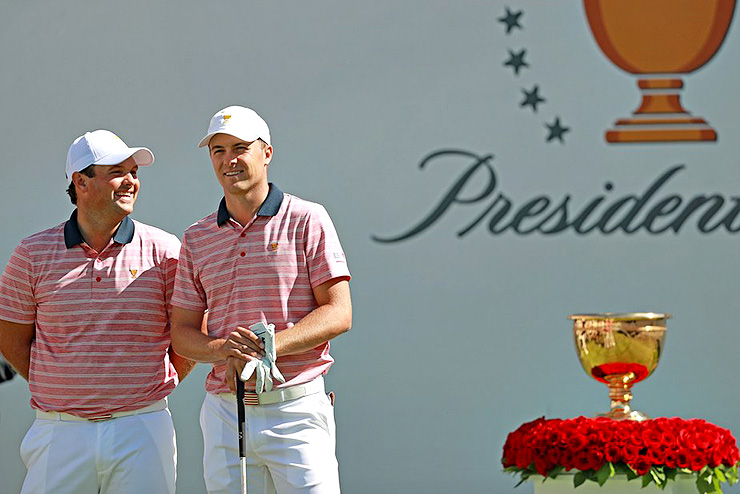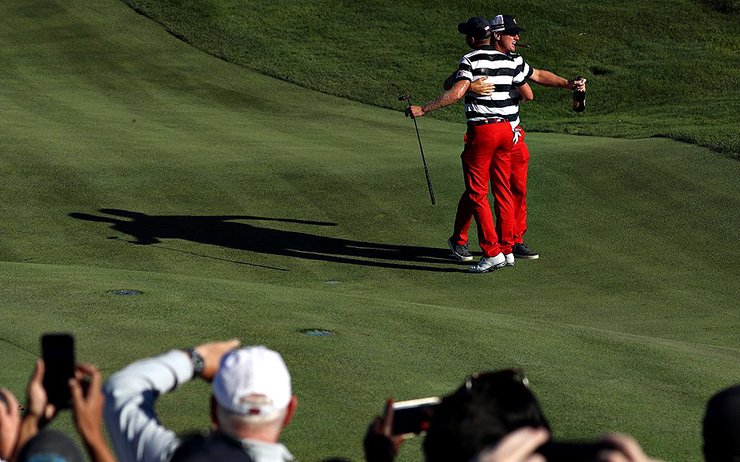By Tim Rosaforte
There were so many bright points for fans of American golf in the lopsided 19-11 United States win at the Presidents Cup that it’s hard to figure out where to start. But this seems like as logical a place as any: By going 3-0-1 as a pair in the first four sessions at Liberty National, Jordan Spieth and Patrick Reed have raised their combined Ryder Cup and Presidents Cup records to 8-1-3. The American Dream Team is playing at such a high level of tenacity and short-game prowess that they are reaching Seve Ballesteros-Jose Maria Olazabal territory.
The Spanish Armada was 8-1-1 in their first 10 matches on their way to an 11-2-2 record in what is regarded as the greatest partnership in Ryder Cup history. They did this during an era when Europe dominated the Ryder Cup the way the United States is beginning to take command of team competitions, starting last September at Hazeltine National and continuing this week outside New York City in what is crystalizing as part of something big for American golf.
Big as in what represents a game changer in regard to international team competition. Watching what Steve Stricker’s team did to Nick Price’s charges the last four days reminds me of those Ryder Cups during and after Seve and Ollie played their best golf. It was a time when you actually felt sorry for the red team on leader boards at burial grounds like The Belfry, the K Club, Celtic Manor and Gleneagles, where the seeds of this American resurgence were planted when Reed and Speith were the lone bright lights, displaying an energy that Seve and Ollie seemed to own.

Scott Halleran/PGA Tour
The pair have a sort of good cop (Spieth)/bad cop (Reed) dynamic that has brought out the best in one another, despite their differing personalities, by the mindset that they’re competing against one another in the same competition. That’s hard to quantify in foursomes, but in four-balls it’s like having a cutthroat bet against your partner.
“I definitely play more aggressive, with his short game and putting,” Reed said after taking down Aussies Jason Day and Marc Leishman, 4 and 3, on a brisk Saturday morning.
“From 10 feet and in, it’s virtually automatic,” Spieth added.
At just 27 and 24, respectively, Reed and Spieth have done what Phil Mickelson and Tiger Woods were unable to do in their prime years. Remember Tiger and Phil when they were awkwardly paired together by Hal Sutton at Oakland Hills in 2004 and how that lack of chemistry led to one of the worst weeks in U.S. Ryder Cup history? Spieth and Reed are not only the opposite of that. They are the new-age foundation in American golf.
Back after the Gleneagles debacle, Mickelson came out looking like the bad guy for how he dressed down captain Tom Watson in that fabled Sunday night news conference. All Mickelson was trying to do as a voice of dissent was ultimately create the system that we have seen play out at Hazeltine National last September and again against the backdrop of the Statue of Liberty and the Manhattan skyline this past week.
I asked Mickelson about this when he was done shimming and shaking with playing partner Kevin Kisner after dropping an 11-footer on the 18th hole of their match against Day and Leishman on Friday afternoon, a victory that put the Americans up 8-2 and foreshadowed the drubbing in store over the weekend. I went in curious about Spieth (who’s only wart in these events is his surprising 0-5 record in singles play) and Reed, but had my eyes opened to the pyramid base that is being created by Phil’s idea and Jordan’s and Patrick’s play.
“They’re extremely tough to beat,” Mickelson told me, “and they are the foundation the United States team is laying with these great young players and the camaraderie and the interaction they have is a great sign, not just for this year, but for years to come.”
The other team Mickelson is anxious to see moving forward is Rickie Fowler, 28, and Justin Thomas, 24. The duo connected for the first time at Liberty National (this was Thomas’ first professional team event), and the Baker’s Bay bros were a natural tandem. Thomas is Fowler’s fourth partner since his Ryder Cup debut in 2010. With his first three partners, that include Mickelson, Reed and Jimmy Walker, Fowler went a combined 2-6-3. With Thomas in tow, he went 2-0-1.
“Rickie is one of the foundational players for the U.S. side going forward, and we haven’t found his partner that he feels invincible with,” Mickelson said. “He and Justin … if they can continue this and carry this momentum, I think it’s going to be something to look at for generations to come, what Spieth and Reed are doing after a couple years.”

Sam Greenwood/Getty Images
Fowler rode that momentum again on Sunday, winning his match with Emiliano Grillo, 6 and 4, for only his second singles win in either team competition. It certainly seems that he has found a new comfort zone in these events.
“I feel like I’m a middle man in a way,” Fowler explained on Saturday. “I’ve had my times on these teams where I know what it’s like, I know how to describe it to some of the younger guys. I’m maybe a little closer in age to them to bridge the gap a little bit. I’ve been able to be around guys like Strick and Tiger and Phil, so maybe it is a little bit in the area age wise and amount of times I’ve played, bridging the gap between these guys that have played a bunch and the guys that are just coming up.”
Even when he’s asked to take off a session, Fowler is at a stage where he can contribute just by following groups. As he told me while Thomas was asked to play with Daniel Berger (another young gun who clinched the winning point on Sunday and, at 24, could be a staple of American teams for years) in Saturday afternoon’s four-ball, “We’ve got a deep team. Sometimes it’s fun to sit back and watch the guys do work.”
With Woods, an assistant captain again this week, standing right next to him, Mickelson believes that camaraderie leads to unity and unity brings out some of the best golf in team environments, “the way Europeans have done for so many years” with foundational players like Hall of Famers Ballesteros, Nick Faldo, Bernhard Langer, Sandy Lyle and Ian Woosnam.
With six Presidents Cup rookies on this year’s team (Thomas, Berger, Kevin Kisner, Brooks Koepka, Kevin Chappell and Charley Hoffman), it has Mickelson playing younger as his anticipated captaincy at the Ryder Cup at Bethpage in 2024 remains seven years away. By then, who knows what new dance moves he will have cooked up.
“This is one of our great teams of young players,” the 47-year-old said with a twinkle in his eyes. “We have players who are going to be on these teams for decades to come.”
So, to the rest of the world, considered you’ve warned. The future of American team golf is here, and it looks damn good.









